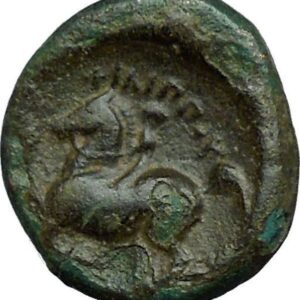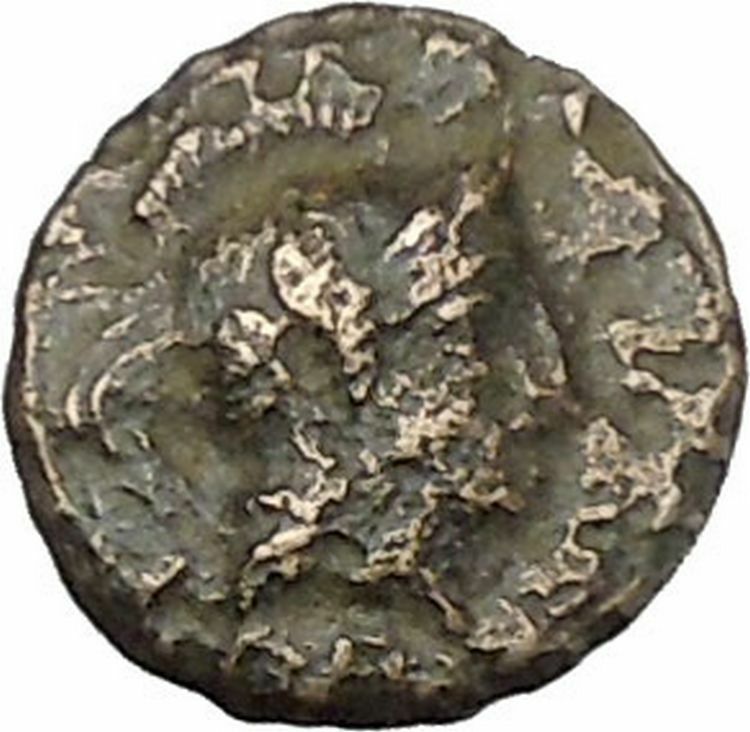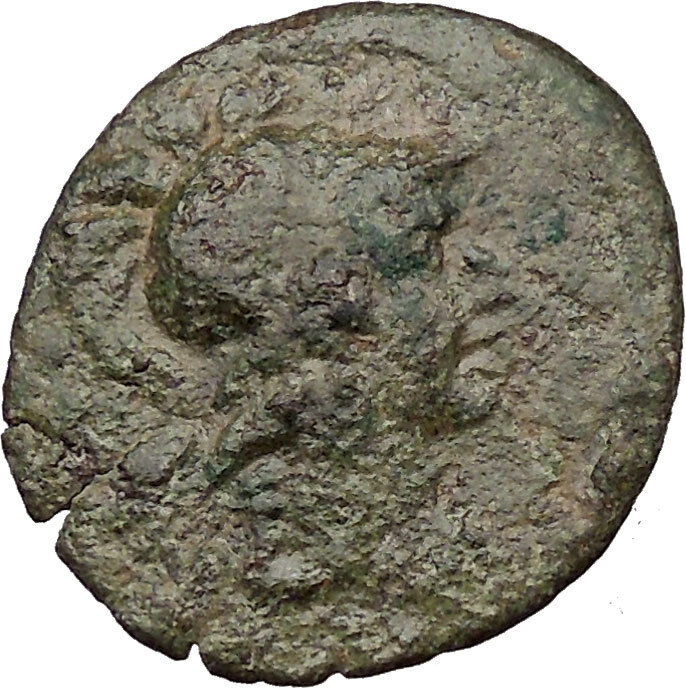|
Greek city of
Panormos
in
Sicily
Bronze As 23mm (6.07 grams) Roman protectorate, After 241 B.C.
Reference: CNS 78; SNG ANS 600.
Laureate head of Janus; I above
NA/SO in two lines; star pattern of pellets above; all within laurel
wreath.
The principal Phoenician city in Sicily, Panormos produced a limited coinage in
the latter part of the 5th Century; but following the great success of
Carthaginian arms, 409-405 B.C., the issues of the mint became much larger. The
types are mostly copied form the coinages of other Sicilian cities, such as Gela,
Segesta and Syracuse.
You are bidding on the exact
item pictured, provided with a Certificate of Authenticity and Lifetime
Guarantee of Authenticity.
In Roman mythology,
Janus
is the god of gates, doors, doorways, beginnings,
endings and time. Most often he is depicted as
having two heads, facing opposite directions; one
head looks back at the last year while the other
looks forward to the new, simultaneously into the
future and the past.
Janus was usually depicted with two heads facing in opposite directions.
According to a legend, he had received the gift to see both future and past from
the god
Saturn
in reward for the hospitality received.
Janus-like heads of gods related to
Hermes
have been found in Greece, perhaps
suggesting a compound god.
The Romans associated Janus with the
Etruscan deity
Ani. Several scholars suggest that he was
likely the most important god in the Roman archaic pantheon. He was often
invoked together with Iuppiter (Jupiter).
According to
Macrobius
and
Cicero
, Janus and Jana (Diana)
are a pair of divinities, worshipped as the
sun
and
moon
, whence they were regarded as the highest
of the gods, and received their sacrifices before all the others.
In general, Janus was the patron of concrete and abstract beginnings of the
world (such as the religion and the gods themselves), the human life, new
historical ages, and economical enterprises. He was also the god of the home
entrance (ianua), gates, bridges and covered and arcaded passages (iani)
named after him.
He was frequently used to symbolize change and transitions such as the
progression of past to future, of one condition to another, of one vision to
another, the growing up of young people, and of one universe to another. He was
also known as the figure representing time because he could see into the past
with one face and into the future with the other. Hence, Janus was worshipped at
the beginnings of the harvest and planting times, as well as marriages, deaths
and other beginnings. He was representative of the middle ground between
barbarity and civilization, rural country and urban cities, and youth and
adulthood.
Numa
in his regulation of the
Roman calendar
called the first month
Januarius
after Janus, at the time the
highest divinity. Numa also introduced the
Ianus geminus
(also Janus Bifrons,
Janus Quirinus or Portae Belli) , a passage ritually opened at
times of war, and shut again when Roman arms rested. It formed a walled
enclosure with gates at each end, situated in the
Roman Forum
which had been consecrated by
Numa Pompilius
. In the course of wars, the
gates of the Janus were opened, and in its interior sacrifices and vaticinia
were held to forecast the outcome of military deeds. The doors were closed only
during peacetime, an extremely rare event.
Livy wrote in his
Ab urbe condita
that the doors of the
temple had only been closed twice since the reign of Numa: firstly in 235 BC
after the
first Punic war
and secondly in after the
battle of Actium
in 31 BC. A temple of Janus is
said to have been consecrated by the consul
Gaius Duilius
in 260 BCE after the
Battle of Mylae
in the Forum Holitorium. The
four-side structure known as the
Arch of Janus
in the
Forum Boarium
dates to the 4th century CE..
In the Middle Ages, Janus was also taken as the symbol of
Ianua, as
well as of other European communes.Genoa
Palermoo is a city in
Southern Italy
, the
capital
of both the
autonomous region
of
Sicily
and the
Province of Palermo
.
The city is noted for its
history
,
culture
,
architecture
and
gastronomy
, playing
an important role throughout much of its existence;
it is over 2,700 years old. Palermo is located in
the northwest of the island of Sicily, right by the
Gulf of Palermo in the
Tyrrhenian Sea
.
The city was founded by the
Phoenicians
, but named by the
Ancient Greeks
as Panormus meaning
“always fit for landing in.” Palermo became part of the
Roman Republic
, the Roman Empire and eventually
part of the
Byzantine Empire
, for over a thousand years.
From 827 to 1071 it was under
Arab rule
during the
Emirate of Sicily
when it first became a
capital. Following the
Norman reconquest
, Palermo became capital of a
new kingdom (from 1130 to 1816), the
Kingdom of Sicily
. Eventually it would be
united with the
Kingdom of Naples
to form the
Two Sicilies
until the
Italian unification
of 1860.
The population of the Palermo
urban area
is estimated by
Eurostat
to be 855,285, while its
metropolitan area
is the fifth most populated
in Italy with around 1.2 million people. In the central area, the city has a
population of around 650,000 people. The inhabitants are known as Palermitans
or poetically panormiti. The languages spoken by its inhabitants are the
Italian language
and the
Sicilian language
, in its Palermitan variation.
Palermo is Sicily’s
cultural
,
economic
and
touristic
capital. It is a city rich in
history
,
culture
,
art,
music
and
food. Numerous tourists are attracted to the city for its good
Mediterranean
weather, its renowned
gastronomy
and
restaurants
, its
Romanesque
,
Gothic
and
Baroque
churches
,
palaces
and
buildings
, and its
nightlife
and
music
.[1]
Palermo is the main Sicilian
industrial
and
commercial
center: the main industrial sectors
include tourism
,
services
,
commerce
and
agriculture
.[2]
Palermo currently has an
international airport
, and a significant
underground economy
.[citation
needed] In fact, for cultural, artistic and economic
reasons, Palermo was one of the largest cities in the
Mediterranean
and is now among the top tourist
destinations in both Italy and Europe. The city is also going through careful
redevelopment, preparing to become one of the major cities of the
Euro-Mediterranean area.
Roman Catholicism
is highly important in
Palermitan culture. The
patron saint
of the city is
Saint Rosalia
. Her
feast day
on July 15 is perhaps the biggest
social event in the city. The area attracts significant numbers of
tourists
each year and is widely known for its
colourful fruit, vegetable and fish
market
at the heart of Palermo, known as the
Vucciria.
History
Ancient era
Evidence for
human settlement
in the area now known as
Palermo goes back to the
Pleistocene Epoch
, around
8000 BC
. This evidence is present in the form
of cave drawings at nearby Addaura writ by the
Sicani
who, according to
Thucydides
, arrived from the
Iberian Peninsula
(perhaps
Catalonia
). During
734 BC
the
Phoenicians
, a sea trading peoples from the
north of ancient Canaan
, built a small settlement on the natural
habour of Palermo. Some sources suggest they named the settlement “Ziz.” The
Greeks
, who were the most dominant culture on
the island of Sicily due to the powerful
city state
of
Syracuse
to the east, instead called the
settlement Panormus. Its Greek name means “all-port” and it was named so
because of its fine natural harbour
. Palermo was then passed on to
the Phoenician’s descendants and successors, the
Carthaginians
.
During this period it was a centre of
commerce
; however a power struggle between the
Greeks and the Carthaginians broke out in the form of the
Sicilian Wars
, causing unrest. It was from
Palermo that
Hamilcar
‘s fleet (which was defeated at the
Battle of Himera
) was launched Palermo
eventually became a
Greek colony
when
Pyrrhus of Epirus
gained it during the
Pyrrhic War
period in
276 BC
. However, as the
Romans
flooded into Sicily during the
First Punic War
, the city came under
Roman rule
only three decades later. The Romans
made sure that, in the words of
Roman consul
M. Valerian to the
Roman Senate
; “no Carthaginian remains in
Sicily”. This period was quite a calm time for Palermo, which was growing into
an important
Roman trade
centre. Also during this period
Christianity
first began to be practised in
Palermo.
|







